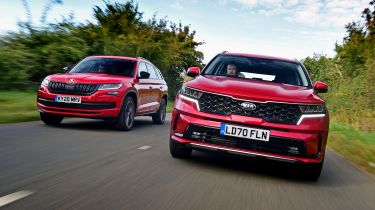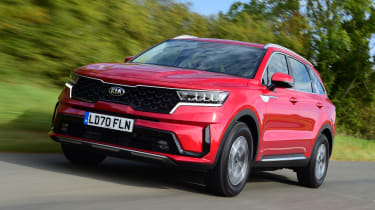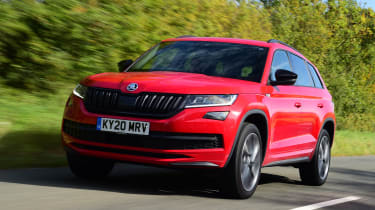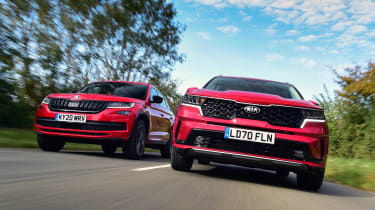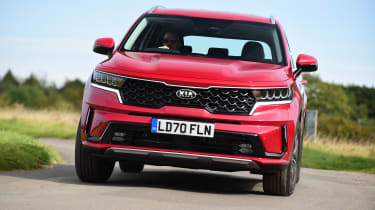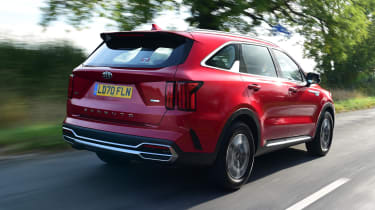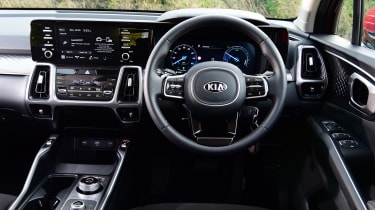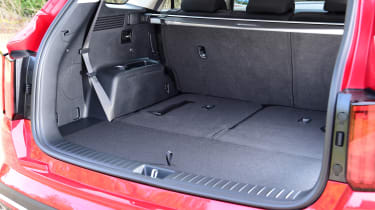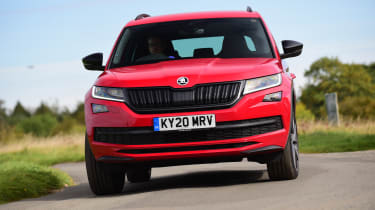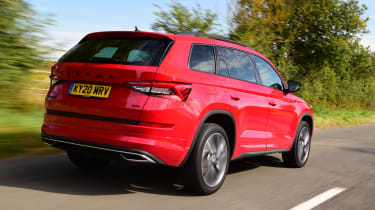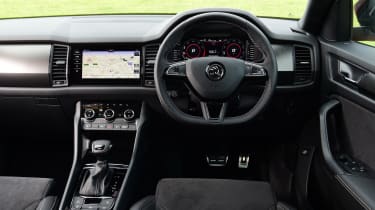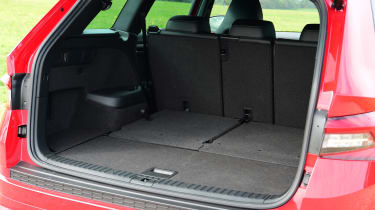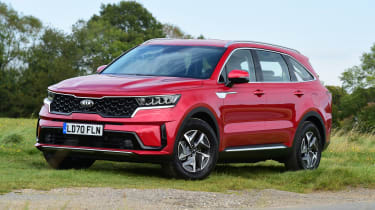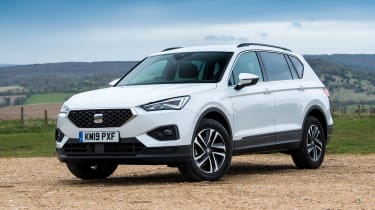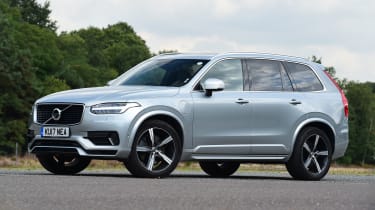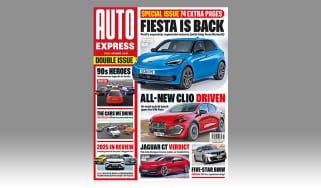Kia Sorento vs Skoda Kodiaq: which is the best used seven-seat SUV for families?
The Skoda Kodiaq takes on the new Kia Sorento in this second-hand family-friendly SUV twin test
It’s more than two decades since the first modern seven-seat SUV was launched. Although 4x4s with three rows of seats first appeared as far back as the sixties, it wasn’t until Volvo released its original XC90 in 2002 that buyers could opt for a truly luxurious and dynamically capable, road-biased SUV. The XC90 was a runaway success for its maker, but it took quite a while for rivals to introduce their own take on the formula; SUVs with two rows of seats remained the norm for ages.
Nowadays, though, there are lots of seven-seat SUVs, and in 2020 we pitted the then-new Kia Sorento Mk4 against the more established Skoda Kodiaq. While the Kia was a hybrid, the Skoda had just a regular petrol engine; there was no hybrid option for the Kodiaq, and a diesel was offered only with mid-range trim for the Sorento.
Each car played the value card heavily, while both contenders were also good to drive and very practical, which is why they are now very tempting used buys.
Kia Sorento
- Prices from £28,000 (Kia Sorento 1.6h T-GDi 2 2020, 50k miles)
- For: Roomy interior, very well equipped, high-quality cabin, lots of safety kit, distinctive looks, long warranty.
- Against: 1.6-litre petrol engine short of muscle, not as comfy or as good to drive as the Skoda.
Used - available now

2024 Vauxhall
Mokka Electric
16,495 milesAutomaticElectric
Cash £14,735
2021 Lexus
NX Hybrid
69,574 milesAutomaticPetrol2.5L
Cash £21,720
2022 Lexus
RX
25,000 milesAutomaticPetrol3.5L
Cash £33,297
2021 Lexus
ES
24,850 milesAutomaticPetrol2.5L
Cash £33,100We love Skodas and they always do well in our Driver Power surveys, because they’re so easy to live with and such good value. The Kodiaq is a case in point, because while it’s a relatively costly car, it’s also Skoda’s biggest model, so you get a lot for your money. Offered with 1.4 (later 1.5) TSI or 2.0 TSI petrol engines, there was also a 2.0 TDI diesel with 114, 148 or 187bhp; a sporty vRS edition arrived in 2019, with a 237bhp 2.0 TDI engine.
Even now, the Kodiaq acquits itself well with its technology, engines and equipment, but the Mk1 Kodiaq was never offered with hybrid or plug-in hybrid power. It’s still good to drive, though, with sharp steering, a comfy ride and decent agility, while performance is good. But the Kodiaq is smaller than the Sorento, so its cabin isn’t as roomy, although a benefit of that is that the Skoda has a bigger boot.
Buy an early, very high-mileage Kodiaq in a private sale and you can pay as little as £10k for it. But £12k is where the market generally starts, while for £17,000, a range-topping 70,000-mile 2.0 TDI SE L 4WD could be yours.
Skoda Kodiaq
- Prices from £12,000 (Skoda Kodiaq 2.0 TDI 150 SE 4WD 2017, 100k miles)
- For: Lots to buy, keen prices, wide model range, good to drive, user-friendly cabin, well equipped.
- Against: No hybrid option, early cars are feeling dated inside, cabin isn’t as spacious as the Sorento’s.
The original Sorento was launched in 2003, and by the time the Mk4 arrived in 2020, Kia had nailed the seven-seat SUV formula. The car came in hybrid and plug-in hybrid forms with a 1.6-litre turbo petrol engine; a 2.2 diesel was also offered, but it came only in mid-range trim (the options were 2, 3 and 4).
Launched on an all-new platform, the Sorento Mk4 is a lovely thing to own, because it’s roomy and well equipped. Cabin quality is good, too, and the ownership experience tends to be a breeze, thanks to decent levels of reliability and that impressive seven-year warranty, which is transferable between owners. But dynamically, the Sorento isn’t as good as the Skoda, because its engine has to work hard in such a big car; that’s why the 2.2-litre diesel is a better bet. The ride also can’t match the Skoda for comfort.
There are a few Sorentos available for a bit under £30,000, but this is the starting point if you want any sort of choice; it buys a 30,000-mile 2.2 CRDi 3 on a 21-plate or a 25,000-mile 1.6h T-GDi 2 that’s a year newer. Plug-in hybrids generally start at £36k for a 20,000-mile car from 2021.
Which one should you choose?
First place: Skoda Kodiaq
Values are lower, there’s much greater availability, plus the model range is far wider. The Skoda is also more comfy and agile, with an even higher-quality cabin.
Second place: Kia Sorento
The Sorento is good, but values are high relative to the Skoda. You get masses of kit, though (especially for safety), a really spacious cabin and decent versatility too.
Kia Sorento vs Skoda Kodiaq new car test: November 2020
Below is our original twin test of the Kia Sorento and Skoda Kodiaq as published in 2020. All information correct at time of publication...
If families need a big people-mover these days, they’re more likely to buy a seven-seat SUV than an MPV. It’s the way fashion and trends evolve, and there’s certainly no denying that this pair of off-roaders look more stylish and appealing than their more van-like counterparts.
That’s why SUVs are so popular, and the number of large cars like this hitting the market shows that this is still the sector for growth, and the most recent to launch is the new Kia Sorento, which is arriving in the UK with a refreshing recipe. There’s one diesel, but the rest of the range is hybrid-powered to meet customer demand.
It’s up against one of our favourites in the class – Skoda’s petrol-powered Kodiaq seven-seat SUV. Although Skoda doesn’t offer hybrid or mild-hybrid versions of its Kodiaq yet, this largest Skoda SUV gets even more kit for similar money.
Kia Sorento
| Model: | Kia Sorento 1.6 Hybrid 2 |
| Price: | £38,845 |
| Engine: | 1.6-litre 4cyl turbo, 226bhp |
| 0-62mph: | 8.7 seconds |
| Test economy: | 42.3mpg/9.3mpl |
| CO2: | 154g/km |
| Annual road tax: | £140 |
There’s lots that’s new for this fourth-generation Sorento, not least its hybrid powertrain. This is expected to be the best-seller in 2 trim, which is priced from £38,845.
Design & engineering
Kia’s seven-seat Sorento SUV is all-new, with the N3 platform designed to accept this hybrid powertrain.
The new platform means the Sorento’s wheelbase is 35mm longer than its predecessor’s, helping improve packaging inside despite only a minimal increase in overall length. There’s fully independent suspension at the rear, which is self-levelling on higher trim levels, but not on this 2 model. The 1.6-litre non-turbo petrol engine, 1.49kWh lithium-ion battery and electric-hybrid powertrain is available on all models, though.
Electric range is limited, but the small battery is more for assisting the petrol engine to help shift the car’s 2,006kg kerbweight, which is 253kg more than the Skoda’s. The powertrain produces 226bhp and 350Nm of torque and it drives all four wheels through a six-speed automatic gearbox.
This Sorento is what Kia calls a ‘self-charging’ hybrid, which means you don’t connect it to mains electricity. Instead, the car manages the state of the battery’s charge and will recoup energy when slowing down or braking, topping up the system with energy that would otherwise be lost, or it’ll use the petrol engine as a generator to ensure the state of charge is maintained at an optimum level.
There’s a lot more tech in this new Sorento too, with plenty of safety features that’ll make this an appealing family car. We’ll come to those shortly.
Inside, the Sorento has been smartened up, with a fresher design and some higher-quality materials. However, you’ll have to shell out nearly £39,000 for this entry-level car, and while quality is fine, there are trim parts that trail those in the Kodiaq.
Driving
The Sorento’s hybrid powertrain makes it relaxed on the move. As long as you don’t push it too hard, the powertrain is relatively refined, calling on the electric motor to do a good chunk of the work.
Use full throttle and the 1.6 unit’s roar grates inside the cabin compared with the smoother-sounding turbo engine in the Skoda, but then around town and on a gentle cruise the Kia is relatively quiet. Its conventional six-speed auto is also smoother than the DSG gearbox in the Kodiaq, so it has the edge for driveability at lower speeds.
However, the Kia’s ride isn’t quite as accomplished as the Skoda’s. The Sorento is soft, but over bumps there’s not as much control, so the wheels move more aggressively and more of this energy is transferred through to the passenger compartment. Still, it’s far from an uncomfortable car.
That weight means it doesn’t handle with anywhere near as much precision as the Skoda, but given the above we’d wager that doesn’t really matter as much as ride comfort in a car of this type.
The weight also means it isn’t as quick. We’ve mentioned about the Sorento sounding less refined under full throttle, and you might have to use more of the throttle’s travel more frequently than in the Skoda. But with a 0-60mph time of 8.7 seconds, performance is adequate.
Practicality
These cars are all about usability, and the Kia excels here. It’s the roomiest in the third row, and the mechanism to fold its seats and access the rear is the best.
The Sorento serves up 179 litres of boot space with all seven seats in place. This rises to 608 litres when the rear seats are folded. The middle-row seats are more spacious than those in the Skoda – they slide in both models – while the Kia offers USB charging points in the rear to keep gadgets topped up.
Fold the middle-row seats down and the Sorento offers a maximum 1,996 litres carrying capacity. This is only a few litres down on the Skoda’s maximum 2,005 litres, so there’s little to split the two here.
Both of these cars are quite large, but the Kia features front and rear parking sensors and a reversing camera as standard. While the Kodiaq has sensors, you’ll have to shell out an extra £405 to add a rear camera as well.
Ownership
The Kia also gets lots of new safety tech. Although Euro NCAP hasn’t yet tested this new Sorento, even 2 trim features autonomous braking with collision warning, as well as pedestrian and cyclist detection. There’s also a new junction-detection function that will stop you from pulling out on approaching traffic by mistake.
On top of this there’s lane-follow assist as part of the smart adaptive cruise control, which also integrates a feature that will automatically adjust the set speed to the speed limit when it changes.
The ownership proposition is boosted by Kia’s seven-year/100,000-mile warranty, as well as the brand’s second-place finish in our 2020 Driver Power owner satisfaction survey.
Running costs
You expect good fuel efficiency from a hybrid, and the Kia’s 42.3mpg was exactly 10mpg more than the Skoda managed, meaning your annual fuel bill will stand at £1,483 based on these figures over 10,000 miles. The Skoda’s fuel bill comes in at £1,884.
Many will buy these cars on finance, but some will still buy with cash, and residual values will have an impact on both. The shift towards hybrids in the market is reflected in the fact our experts predict the Kia will retain 46 per cent after three years/36,000 miles, which equates to depreciation of £20,996.
The Skoda is rated at just 38.7 per cent over the same period, which means it will lose £23,830, so the Kia has an advantage when it comes to running costs.
Testers’ notes
“The Kia’s lithium-ion battery is covered by the seven-year warranty so there’s plenty of peace of mind alongside one year’s free roadside assistance cover.”
Skoda Kodiaq
| Model: | Skoda Kodiaq 2.0 TSI 190 DSG 4x4 SportLine |
| Price: | £38,880 |
| Engine: | 2.0-litre 4cyl turbo, 187bhp |
| 0-62mph: | 7.6 seconds |
| Test economy: | 33.3mpg/7.3mpl |
| CO2: | 198g/km |
| Annual road tax: | £150 |
The Kodiaq is at the sharp end of the seven-seat SUV class, and this SportLine trim, positioned towards the top of the Kodiaq range, is very close on price to the Sorento, starting from £38,880.
Design & engineering
The Kodiaq has been on sale from late 2016, so it’s now one of the older large SUVs on sale. But updates throughout the car’s life have kept it at the cutting edge of the class, with new tech features, engines and trim levels, which this 2.0 TSI 190 4x4 DSG SportLine model represents.
The Skoda’s chassis is based on the VW Group’s MQB architecture, which is a scalable platform that underpins a whole range of vehicles from the Audi TT sports car to this Skoda family SUV.
Both cars here are four-wheel drive, so their suspension layouts are identical, with MacPherson struts at the front and a multi-link set-up at the rear. The Skoda is available with adaptive dampers for an extra £1,030, which also adds an off-road setting.
Where the two differ in their engineering approach is that the Skoda isn’t available as a hybrid. The market has swung towards petrol, so this 2.0 TSI 190 model is now a more popular choice. The four-cylinder turbo engine produces 187bhp – a little down on power compared with the Kia – but with an identical 320Nm of torque produced at the same 1,500rpm yet a kerbweight of just 1,753kg, making it considerably lighter, the Skoda is the quicker car.
It has a dual-clutch gearbox and four-wheel drive, with selectable driving modes that include Eco, Comfort, Sport and Off Road settings. The latter matches the Kia, but the Sorento also has the choice of mud, snow and sand as part of its Terrain setting. In reality few will take either of these pair off the beaten track, but both will be fine for light off-roading.
These cars will likely spend more time on road, where the Skoda’s higher-quality cabin will come into its own. The Kia’s is fine, but the Skoda’s feels decidedly plusher, even if its design is best described as plain and simple. It has been on sale without any interior tweaks since late 2016, but the layout is functional and works well.
Driving
It’s clear that the Skoda is the more driver-focused model of the two, especially in SportLine spec. The steering is sharper, and you can sense its comparatively lower mass relative to the Kia because it feels more agile and grips more tenaciously. The engine pulls strongly and delivers good performance too, covering 0-62mph in 7.6 seconds.
Despite better body control, the Kodiaq is actually the softer, more comfortable car. It doesn’t lumber over corrugations in the road like the Kia does. The Skoda does lose its composure on undulating roads a little, with a kind of nodding motion, but on the whole it’s the more interesting and able machine to drive, and also the more comfortable.
Powertrain refinement is on par with the Kia’s at cruising speeds, but under hard acceleration the Sorento is noisier than the smoother Kodiaq; once the majority of the electrical assistance has been provided in the Kia, the 1.6 struggles. In the Skoda the larger engine doesn’t have to work as hard.
Practicality
Seven-seat SUVs are all about size. The Skoda is 10cm shorter than the Kia and also has a shorter wheelbase. While the Kodiaq has sliding middle-row seats like the Kia, it feels less spacious – this is obvious once you get into the very back row, where the Kodiaq is more cramped. It’s also harder to climb into the third row.
The trade-off for the small rear cabin is a decent boot. There are 270 litres in seven-seat form, between 560 and 705 litres with the third row folded, depending on where the middle seats are, and 2,005 litres with them all flat. There’s a powered tailgate, too.
Skodas are known for their practicality and the brand’s Simply Clever touches, and the Kodiaq is no exception. Little extras, such as an ice scraper in the fuel filler flap and an umbrella in the front door make the Kodiaq easy to live with. You can also specify options such as door-edge protectors to avoid car park dings, and small bins as part of the £180 Family Pack. The £325 Sleep Pack adds special headrests for the middle row, acoustic glass and blinds. There’s no wireless charging, as in the Kia, but the Skoda doesn’t offer as many USB ports.
Ownership
Nor does the Skoda offer as much standard safety tech. Autonomous braking with collision warning is standard, but lane assist and blind-spot detection are part of a £980 pack; adaptive cruise is £500 extra.
The Skoda is still a full five-star-rated car by Euro NCAP, but remember that the assessment was carried out in 2017, when the test wasn’t as strict.
Skoda is traditionally a strong performer in our owner satisfaction survey, and it showed strongly in Driver Power 2020. However, its fifth-place finish wasn’t enough to beat second-placed Kia, while Skoda’s standard warranty isn’t as generous either.
Running costs
The Kia’s hybrid powertrain means it emits 158g/km of CO2, which puts it in the 34 per cent Benefit-in-Kind tax band for company car drivers. This compares with a figure of 198g/km for the Skoda, which puts it in the top 37 per cent BiK band.
As a result, the Sorento will cost higher-rate taxpayers £5,203 a year; the same person would have to shell out £5,553 a year for the Kodiaq.
Skoda offers an affordable two-year servicing pack for £369, but Kia is yet to confirm maintenance prices for the Sorento. The Kodiaq will be cheaper to insure, too. We received quotes of £456 and £538 for our sample driver on the Skoda and Kia respectively.
Testers’ notes
“The Kodiaq has a neat double-glovebox feature for extra practicality – the top bin is a good place to store phones, the bottom will take larger items.”
Verdict
First place: Kia Sorento
It's a pricey car, but the Sorento is a solid seven-seat SUV. Affordable running costs and strong residual values help offset its price, while 2 trim’s tech is just enough. However, for family transport the excellent standard safety kit and superb level of space and flexibility are what make the Sorento so usable. We’d like a little more comfort, but performance is okay and efficiency great.
Second place: Skoda Kodiaq
The Kodiaq is still a great SUV, but SportLine isn’t the sweet spot. SE L is more affordable yet basically as well equipped, and while the Skoda performs better, is more agile and more comfortable, it’s more cramped than the Kia and offers less flexibility from its seating layout. Quality is good, but the margin over the Sorento in this respect isn’t enough to secure victory.
Also consider...
- New: SEAT Tarraco 2.0 TSI DSG 4x4 X’ce
- Price: £37,430
- Engine: 2.0-litre 4cyl, 187bhp
SEAT’s seven-seat Tarraco SUV is more affordable than both rivals here, yet in Xcellence spec gets a massive amount of kit that sees it compete with the Kia. The powertrain is the same as the Skoda’s so it’s great. It’s still our favourite seven-seat SUV.
- Used: Volvo XC90 T8 Twin Engine
- Price: £39,990
- Engine: 2.0 4cyl PHEV, 385bhp
For a little more than the Kia you could buy a two-year-old premium seven-seat plug-in hybrid. The Volvo XC90 T8 in desirable R-Design Pro trim has nearly as much space but more luxury, power and potential efficiency.
Figures
| Kia Sorento ‘2’ 1.6 Hybrid | Skoda Kodiaq 2.0 TSI 190 DSG 4x4 SportLine | |
| On the road price/total as tested | £38,845/£39,495 | £38,880/£40,895 |
| Residual value (after 3 years/36,000) | £17,849/46.0% | £15,050/38.7% |
| Depreciation | £20,996 | £23,830 |
| Annual tax liability std/higher rate | £2,602/£5,203 | £2,776/£5,553 |
| Annual fuel cost (12k/20k miles) | £1,483/£2,472 | £1,884/£3,140 |
| Insurance group/quote/VED | 30/£538/£140 | 25/£456/£150 |
| Cost of 1st/2nd/3rd service | TBC | £396 (2yrs) |
| Length/wheelbase | 4,810/2,815mm | 4,699/2,790mm |
| Height/width | 1,695/1,900mm | 1,685/1,882mm |
| Engine | 4cyl in-line/1,598cc | 4cyl in-line/1,984cc |
| Peak power/revs | 226/5,500 bhp/rpm | 187/4,200 bhp/rpm |
| Peak torque/revs | 350/1,500 Nm/rpm | 320/1,500 Nm/rpm |
| Transmission | 6-spd auto/4wd | 7-spd DSG/4wd |
| Fuel tank capacity/spare wheel | 67 litres/space saver | 61 litres/repair kit |
| Boot capacity (7/5/2 seats) | 179/608/1,996 litres | 270/560-765/2,005l |
| Kerbweight/payload/towing weight | 2,006/604/1,650kg | 1,753/667/2,000kg |
| Turning circle | TBC | 11.6 metres |
| Basic warranty/recovery | 7yrs (unlimited)/1yr | 3yrs (60,000)/3yrs |
| Driver Power manufacturer/dealer pos. | 2nd/5th | 5th/10th |
| NCAP: adult/child/ped/assist/stars | TBC | 92/77/71/54/5 (2017) |
| 0-62mph/top speed | 8.7 secs^/119mph | 7.6 secs/131mph |
| Auto Express econ (mpg)/range | 42.3/623 miles | 33.3/447 miles |
| WLTP combined (mpg) | 40.9mpg | 30.1-32.1mpg |
| WLTP combined (mpl) | 9.0mpl | 6.6-7.1mpl |
| Actual/claimed CO2/tax bracket | 154/158g/km/34% | 196/198g/km/37% |
| Airbags/Isofix/park sensors/camera | Six/yes/F&R/yes | Seven/yes/F&R/£405 |
| Auto box/lane keep/blind spot/AEB | Yes/yes/no/yes | Yes/£980*/£980*/yes |
| Climate control/cruise | Yes/adaptive | Yes/yes |
| Leather/heated seats | No/yes | No/yes |
| Metallic paint/LED lights | £650/yes | £380/yes |
| Keyless go/powered tailgate | No/no | Yes/yes |
| Sat-nav/digital dash | No/yes | Yes/£470 |
| DAB/connected services | Yes/yes | Yes/yes |
| Wireless charging | No | No |
| Apple CarPlay/Android Auto | Yes/yes | Wireless/yes |
